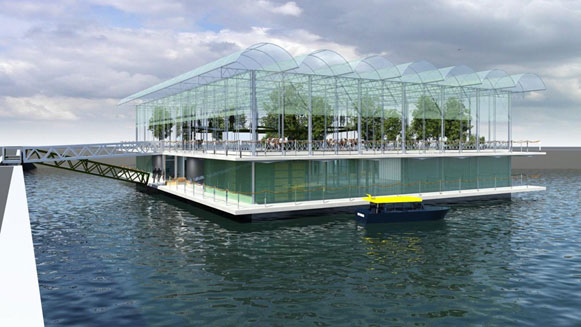In Rotterdam Green Acres Meet Green Seas
Rotterdam floating dairy farm proposes food delivery to coastal cities and emergency backup
How fast does a cow get its sea legs – we’ll soon see as an innovative approach to farming gets underway in the Netherlands. In the Port of Rotterdam, a floating concrete barge is being constructed that will contain a floating dairy farm to produce milk, yogurt and other dairy products.
Minke van Wingerden, a partner at Beladon BV - the floating farm builder, told AJOT that the original idea for the farm came from a visit to New York after Hurricane Sandy in 2012. She and her husband, Peter van Wingerden, saw that food supplies were disrupted for days in the New York and New Jersey areas after the hurricane hit. Flooding and road damage prevented trucks from making deliveries. This food supply and transportation disruption has been repeated during Hurricanes Katrina, Maria and mostly recently with Hurricane Michael in Florida.
The van Wingerdens began researching ways to improve food deliveries during such emergencies. Originally they focused on supporting more urban or rooftop gardens, but instead shifted to a popular trend in the Netherlands to offset limited and expensive land by building floating houses and offices.
So, they decided to build a floating farm.
The floating farm, Minke van Wingerden said, can adapt to changes in the climate and be hurricane-resistant.
“You go up and down with the tide, or the water, and it has no influence on your food production, so you can still make fresh food in the city,” she said.
“During our research, we saw that many cities are built on or near the sea and along rivers and deltas just as we see here in the Netherlands. This gave us the idea for the floating dairy farm so that the food supply could be brought closer to cities and consumers using floating structures.”

Privately, while they applaud the innovation, some people in Rotterdam think that the dairy products from the floating farm will cost too much and will not compete with land-based dairy farms.
Van Wingerden concedes that the cost of producing milk products will be higher from a floating farm than from a land-based farm.
However, she argues that the Beladon floating farm will be located close to Rotterdam consumers reducing transportation costs and providing fresher products with faster delivery times.
The added advantage is that the floating farm will have a much smaller CO2 foot print than conventional farms: “We will use solar panels to power the farm and use rain water from the roof to supplement our water supply.”
To reduce the environmental impact further: “We will be using existing food waste to feed our cows. There is a brewery nearby so we will use the beer broth that is a product of brewing beer and feed it to our cows. They love it. Another source of food for the cows is potato peels from a food processor. In both cases these waste products would be burned or dumped onto a garbage disposal site. Instead, we feed the product to our cows.”
She hopes that companies like Amazon, and its Whole Foods subsidiary, will find that the Beladon floating farm fits into their fast delivery and organic food business model: a new technological creation to source dairy and other farm products requiring only an urban pier base of operations.
Van Wingerden said the floating farm is estimated to cost 2.6 million Euros. Its dimensions are 30 meters by 30 meters or 89 feet by 89 feet. She expects the first cows to board the floating farm “by the end of the year.”
The floating farm under construction at Rotterdam in September
The structure will be based on a concrete floating base. The second deck is composed of a kitchen to mix the feed for the cows, a processing facility for milk and yogurt products and a shop to sell the milk products. The top deck will be the pasture for forty cows that is connected by a bridge to allow the cows to walk off the farm and on to a land-based pier space for more walk-around space.
Van Wingerden describes the floating farm as “a floating laboratory” for developing new food supplies closer to cities on sea coasts or adjoining rivers and lakes.
She believes Asia will be a major market for the floating farm because many cities are located close to a body of water. There, she sees China as a major market, not just because of the large population living by the coast, but also because of the cities located along rivers such as the Yangtze.
Beladon is also looking at markets in Europe and North America, especially along the Atlantic and Pacific coasts.
Floating farms can help address rising demand for food by bringing farm production closer to consumers and providing sustainable advantages that lower the carbon foot print and provide an organic food product.
Beladon believes these advantages will help mitigate the lower cost advantage of larger land-based farms, which rely on trucking and diesel-powered harvesting.
© Copyright 1999–2024 American Journal of Transportation. All Rights Reserved

